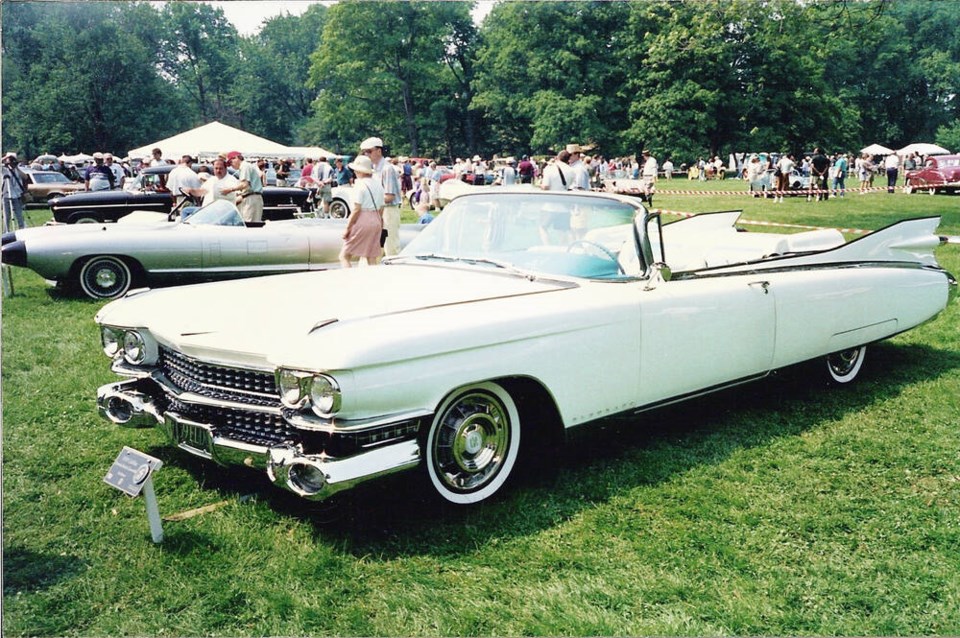The 1959 Cadillac, the self proclaimed “Standard of the World,” was a garish end to a garish decade. It was a period in which Detroit produced some of the most flamboyant cars in its history. Ironically, it also produced some of the most attractive; the Studebaker Starlight/Starliner and early Hawk coupes and 1955 Chevrolets come to mind.
The ’59 Cadillac epitomized an era of soaring fins, excess chrome, wraparound windshields, massive bumpers, fake air scoops and juke-box grilles.
It culminated the period of unprecedented optimism that followed the deprivations of the Depression and the Second World War, the last blowout before some restraint began returning to car styling in the sixties.
The ’59 Caddy’s most prominent feature was tailfins that soared to unprecedented heights, capped by menacing- looking chrome-plated points. They housed twin taillights in sculpted pods with a rocket plane theme that could have been the epitaph to Harley Earl, General Motors’ soon-to-retire chief stylist.
Earl had “invented” styling at GM with the 1927 LaSalle and consolidated it with his trend- setting 1938 Buick Y-Job concept car. After the war, he launched his futuristic jet- and-rocket inspired movement with the 1951 Buick LeSabre “dream car” with its wraparound windshield. Tailfins were another of his big breakthroughs.
Earl’s tailfins had a direct aircraft connection. In the early 1940s he became enamoured with the twin-tailboom stabilizers on the Lockheed Lightning P-38 fighter planes he saw flying out of Selfridge Air National Guard base near Detroit.
With the Second World War shutting down car production in 1942, it was six years before Earl’s P-38-inspired fins could make the transfer to automobile styling. They appeared cautiously on the redesigned 1948 Cadillac as little more than raised taillights.
Although somewhat hesitantly accepted at first, tailfins soon became Cadillac’s styling signature. They transformed the rear of the car, giving it as well as the front a distinctive appearance. They began a styling revolution that by the late 1950s was de rigueur on American cars.
Ford’s 1957 models began growing wings, Studebaker spoiled its lovely coupes by bolting on tailfins, and the 1959 Chevrolet grew thin, bird-like horizontal appendages. The trend became so pervasive that even staid Mercedes-Benzes sprouted small fender blades.
When Chrysler’s 1957 products appeared with fins so huge they threatened to wrench styling leadership from GM, it was a challenge Cadillac couldn’t ignore. The grotesquely befinned 1959 Cadillac was the response.
In addition to fins, the ’59 Cadillac was overstated at every turn. Its front end displayed a sweeping, complex grille that in most Cadillac models was echoed by another grille in the rear. The front parking lights and turn signals were in pods at each end of the substantial bumper. More jet-like pods housed the back-up lights in the rear bumper.
Cadillacs came in five series: 62; DeVille; Eldorado; 60 Special and 75. All had a 3,302 mm (130 in.) wheelbase except the 75, which stretched to 3 ,805 mm (149.8 in.). Cadillacs were a garage-busting 5,790 mm, or almost 19 feet long, except the Series 75 that stretched an astonishing 6,218 mm (20.4 ft).
Under the hood could be found the short-stroke, overhead valve V-8 engine that Cadillac had introduced in 1949, now grown from its original 5.4 litre (331 cu in.) and 160 horsepower to 6.3 litres (390 cu in.) and a standard 325 horsepower. The Eldorado got 345, optional in other models.
Equipment was generous, but far from as extensive as we now take for granted in most cars. A Hydra-Matic transmission was standard, as were power brakes, steering and seats. Still optional were air conditioning, power windows and door locks and cruise control.
Passengers enjoyed a panoramic view thanks to Earl’s beloved and dramatically curved wraparound windshield and thin roof pillars all around. This plus the high fins enabled the driver to see all corners of the car, making it a little less likely that hapless pedestrians would be impaled on those lethal fins.
After the extravagant styling statement of their 1959 models, even Cadillac stylists must have realized they had gone a little too far. For 1960 the fins were toned down and the taillights were nicely integrated. By 1965 Cadillac’s fins were gone altogether.
Depending on your perception, the 1959 Cadillac stood as either the pinnacle of American automotive styling, or its nadir. It was often reviled and vilified as the quintessential example of American decadence and excess in an era when inner cities were rotting and many went to bed hungry. Its kind would never be seen again.
But time changes all things and now the 1959 Cadillac has evolved into an icon of Americana, a touchstone of its era. It has become very collectible, with good examples selling for many times the original price.



